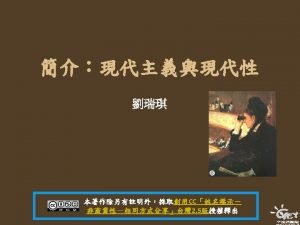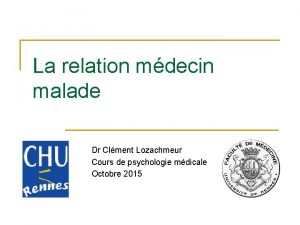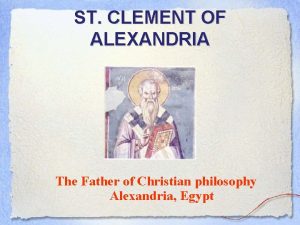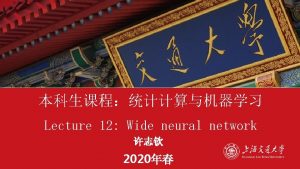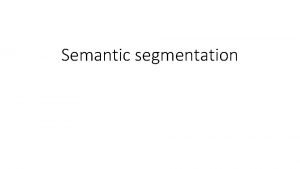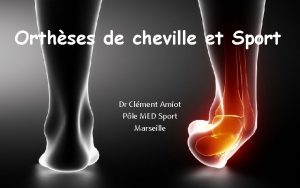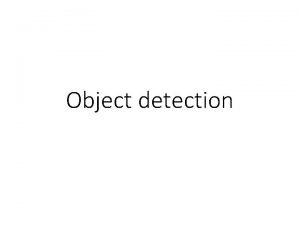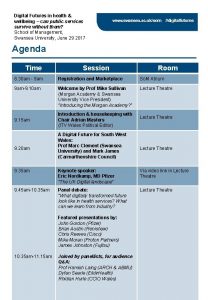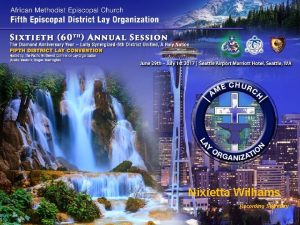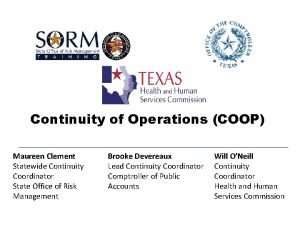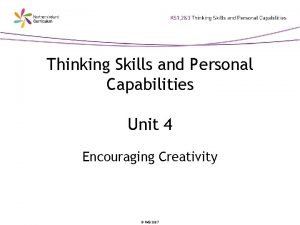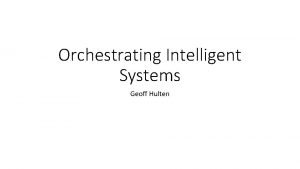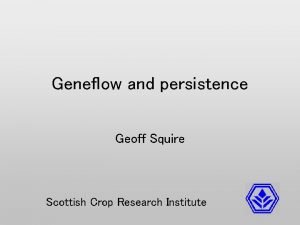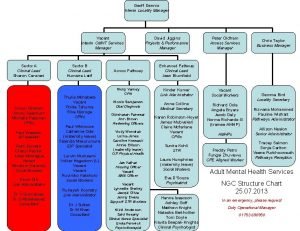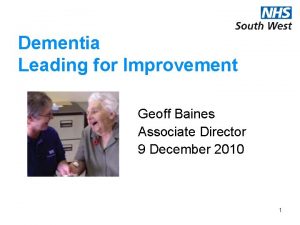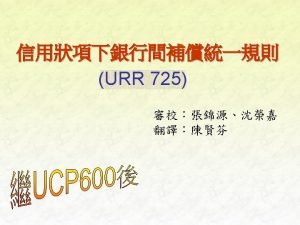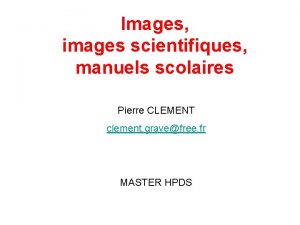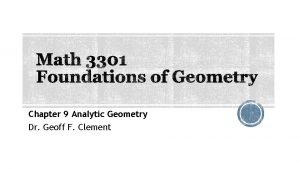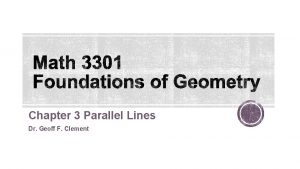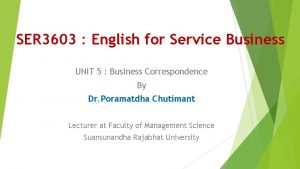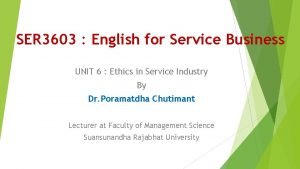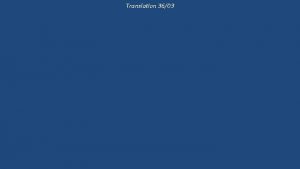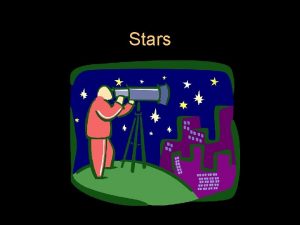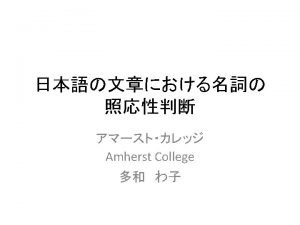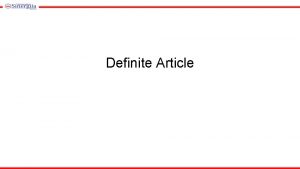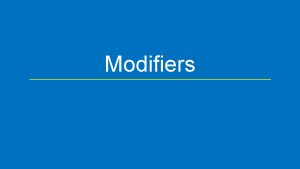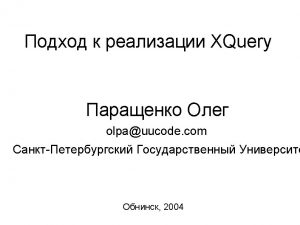ECE 3603 Article Presentation DR GEOFF F CLEMENT




















- Slides: 20

ECE 3603 Article Presentation DR. GEOFF F. CLEMENT APRIL 8, 2019 Carpenter, T. P. , Fennema, E. , & Franke, M. L. (1996). Cognitively guided instruction: A knowledge base for reform in primary mathematics instruction. The Elementary School Journal, 97(1), 3 -20.

Reference Details Tom Carpenter was Professor Emeritus of Curriculum and Instruction at the University of Wisconsin-Madison, where he taught for 25 years. He is the former editor of the NCTM Journal for Research in Mathematics Education, and has received the NCTM Lifetime Achievement award for Distinguished Service to Mathematics Education (2004) among other awards. Tom passed away in August 2018, leaving behind a vast legacy to mathematics education thanks to his research into Cognitively Guided Instruction (CGI). That work, created by him and his team of researchers and authors, is available to all teachers in his influential and popular books Children's Mathematics, Thinking Mathematically, and Young Children's Mathematics. In addition, members of Tom's team have already begun the process of extending his work in CGI with Extending Children's Mathematics, which applies CGI principles to decimals and fractions.

The CGI Book series

Reference Details Cognitively Guided Instruction is a professional development program based on an integrated program of research on (a) the development of students mathematical thinking; (b) instruction that influences that development; (c) teachers knowledge and beliefs that influence their instructional practice; and (d) the way that teachers’ knowledge, beliefs, and practices are influenced by their understanding of students mathematical thinking. CGI is an approach to teaching mathematics rather than a curriculum program. At the core of this approach is the practice of listening to children s mathematical thinking and using it as a basis for instruction. Research-based frameworks of children’s thinking in the domains of addition and subtraction, multiplication and division, base-ten concepts, multidigit operations, algebra, geometry, and fractions provide guidance to teachers about listening to their students. Case studies of teachers using CGI have shown the most accomplished teachers use a variety of practices to extend children s mathematical thinking. It’s a tenet of CGI that there is no one way to implement the approach and that teachers’ professional judgment is central to making decisions about how to use information about children’s thinking.

Summary In this article we propose that an understanding of students' thinking can provide coherence to teachers' pedagogical content knowledge and their knowledge of subject matter, curriculum, and pedagogy. We describe a research-based model of children's thinking that teachers can use to interpret, transform, and reframe their informal or spontaneous knowledge about students' mathematical thinking. Our major thesis is that children enter school with a great deal of informal or intuitive knowledge of mathematics that can serve as the basis for developing much of the formal mathematics of the primary school curriculum. The development of abstract symbolic procedures is characterized as progressive abstractions of students' attempts to model action and relations depicted in problems. Although we focus on one facet of teachers' PCK, we argue that understanding students' thinking provides a basis for teachers to reconceptualize their own knowledge more broadly.

Highlights MKT consists of Knowledge of subject matter Knowledge of pedagogy PCK (Shulman, 1986) Students construct knowledge rather than simply assimilate some part of what they are taught (Cobb, 1994; Davis, Maher, & Noddings, 1990).

Highlights of other projects Purdue Problem-Centered Mathematics Projects Teachers are provided with problem-centered mathematical activities and teaching strategies. Teachers start to question their conceptions of what it means to learn mathematics and develop in their understanding of children’s thinking. Summer. Math for Teachers program (Schifter & Fosnot, 1993) Teachers develop an appreciation of students’ thinking as they reflect on their own learning as they are immersed in a constructivist teaching environment.

Highlights of CGI The CGI PD focused more directly on helping students understand children’s thinking by helping them construct models of the development of children’s thinking in well-defined content domains. This article focuses on children’s conceptions of whole number operations involving single-digit and multidigit numbers, fraction knowledge (Baker, 1994; Baker, Carpenter, Fennema, & Franke, 1992), and geometry and measurement (Lehrer, Fennema, Carpenter, & Ansell, 1992).

Highlights of CGI “Children bring to school informal or intuitive knowledge of mathematics that can serve as the basis for developing much of the formal mathematics of the primary school curriculum” (p. 6). Children intuitively solve word problems by modeling the action and relationships described in them.

Highlights of CGI Addition and Subtraction Four basic classes of addition and subtraction problems can be identified: Joining action Separating action Part-part-whole relations Comparison situations Problems within a class vary depending on which quantity is unknown (start, change, or result). The research base for the analysis of students’ strategies is summarized in Carpenter (1985) and Fuson (1992).

Highlights of CGI Addition and Subtraction TJ had 13 chocolate chip cookies. At lunch he ate 5 of those cookies. How many cookies did TJ have left? Jenelle has 7 trolls in her collection. How many more trolls does she have to buy to have 11 trolls? Willy has 12 crayons. Lucy has 7 crayons. How many more crayons does Willy have than Lucy?

Highlights of CGI Children’s Strategies Direct-modeling strategies are replaced initially by counting strategies, which are essentially abstractions of the direct-modeling strategies. For instance, counting on from the larger number in a problem requires at least some implicit knowledge of commutativity for addition. The next level is derived solutions, which often involve doubles (4 + 4, 7 + 7, etc. ) and sums of 10 (7 + 3, 4 + 6, etc. ), and properties including the distributive, associative, and commutative properties.

Highlights of CGI Multiplication and Division In a multiplication problem, the number of sets and the number in each set are given, and the solution is the total number. In a measurement division problem, the goals is to find the number of sets when the total number and the number in each set are given. In a partitive division problem, the total number and the number of sets are known, so the goal is the number in each set.

Highlights of CGI Multiplication and Division Naomi has 3 pockets. On each pocket, there are six buttons. How many buttons does Naomi have? Our class has 5 boxes of doughnuts. There are 10 doughnuts in each box. We also have 3 extra doughnuts. How many doughnuts do we have altogether? Jim picked 54 flowers. He put them into bunches with 10 flowers in each bunch. How many bunches did Jim make?

Highlights of CGI Multiplication and Division Student methods include: Direct modeling (building arrays, partitioning, measuring, including with groups of 10, 100, or 1000) Counting Derived number facts (often based on what students know about addition and subtraction, and frequently involve doubling and the distributive property) Place value knowledge isn’t completely constructed by students; “many children come to school with some implicit knowledge about the base 10 number system that they have picked up in learning to count, from experience with money, from interactions with adults, and other activities involving numbers (Carpenter, Ansell, Levi, Franke, & Fennema, 1995)” (p. 9).

Highlights of CGI Multiplication and Division Contexts include Rate problems Price or cost problems Multiplicative Array comparison problems and area problems Cartesian products

Highlights “Children strive to use increasingly efficient strategies” (p. 10) and naturally develop “increasingly sophisticated understandings of base 10 numbers” (p. 10). Invented algorithms are constructed through progressive abstraction of their modeling procedures with blocks. In CGI classrooms, students are called on to articulate their solutions, to describe in words what they have done with the blocks.

Highlights CGI teachers are significantly more successful in identifying problems their students can solved and the strategies they use to solve them than non-CGI teachers (Carpenter, Fennema, Peterson, Chiang, & Loef, 1989)” (p. 14). “I have always known that it is important to listen to kids, but before I didn’t know what questions to ask or what to listen for (Carpenter et al. , 1989, p. 530)” (p. 14).

Personal Reactions This really is a must-read for anyone interested in CGI. It’s an early article in the CGI research, with an emphasis on: (1) the 14 problem types for addition, subtraction, multiplication, and division; and (2) children’s solution strategies from direct modeling and counting to recalled facts and invented algorithms.

Connections to our MATH 3003 course Besides probability and statistics, CGI is the big emphasis of this course, and many of the problem-solving tasks in the article were nice review of CGI problem types and children’s natural progression in strategies for problem solving. The appendices were full of problem types and children’s strategies for addition, subtraction, multiplication, and division, plus multidigit strategies.
 Modernist painting greenberg
Modernist painting greenberg Dr lozachmeur
Dr lozachmeur Clement of alexandria paedagogus
Clement of alexandria paedagogus Odile clement
Odile clement Jacot ntk
Jacot ntk Clement farabet
Clement farabet Clement amiot
Clement amiot Clement farabet
Clement farabet Marc clement swansea university
Marc clement swansea university Mieke clement
Mieke clement Bishop clement fugh
Bishop clement fugh Maureen clement
Maureen clement Watchdog dad
Watchdog dad Significance of icedip model
Significance of icedip model Geoff hulten
Geoff hulten Geoff hollington
Geoff hollington Geoff squire
Geoff squire Geoff savage
Geoff savage Geoff wilson lexington ky
Geoff wilson lexington ky Lurvin munisami
Lurvin munisami Geoff baines
Geoff baines
